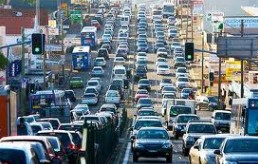
Alan Kohler continues his recent conversion to skeptic of Australia’s population ponzi, arguing today in The Australian that government budgets are failing to keep up with population growth, which is placing pressure, in particular, on the nation’s infrastructure and requiring increased investment:
…Australia’s population grew by nearly 8000 people per week last year and more than half of them landed in Melbourne and Sydney.
That population growth results in overall GDP and domestic consumption spending growing at close to trend, even though in per capita terms it is flat. It’s great for businesses, but governments can’t keep up. Roads are clogged and public transport is groaning. The health and education systems can’t cope with demand.
The fundamental problem is that none of Australia’s governments can fund capital works from recurrent revenue because they are running deficits. All capital expenditure has to be borrowed…
Kohler’s latest warning follows the declaration of an “infrastructure emergency” earlier this year on the back of rapid population growth:
Immigration has increased five-fold since the Howard government came to office…
One obvious consequence of Australia’s population boom, apart from disguising a fundamentally weak economy, is rising house prices because not enough houses are being built as a result of restrictive planning laws and high construction costs.
Not enough infrastructure is being built either, to the point where a national emergency is approaching.
I obviously support increased infrastructure investment on the proviso that it is well-targeted, based on robust cost-benefit analysis, and adds the productive capacity of the economy and/or living standards. Investment of this kind offers Australia the double dividend of supporting growth and jobs as the mining investment boom fades, whilst also expanding Australia’s productive base and improving living standards.
Increased borrowings required to support such infrastructure investment should also not necessarily be seen as a roadblock. Since benefits from infrastructure investment are spread over many years (even generations), it makes sense to also spread their cost. Further, projects that significantly boost productivity can be “self-liquidating” – essentially funded by the increased productivity (and therefore tax revenue) that they create.
That said, infrastructure investment required merely to support Australia’s population ponzi can be problematic, in that it can drain the nation’s productivity by crowding-out productive investment and capital deepening. As explained recently by Dr Katherine Betts from the Monash University Centre for Population and Urban Research:
The Productivity Commission report on ageing points out that the infrastructure spending needed to manage population growth over the next 50 years will be five times the total that was needed over the last 50 years. This investment in capital widening must seriously weaken Australia’s capacity to invest in the capital deepening that would boost productivity…
Population growth imposes pressures on infrastructure and adds to congestion; in so doing it depresses productivity.
International comparisons show that there is no association between population growth and growth in per capita GDP. This is not surprising as comparative data on 32 OECD countries show no positive association between population growth and growth in labour productivity…
Assertions that immigration-fuelled population growth will boost productivity remain conjectural. There is no empirical evidence that such growth in an advanced economy increases productivity.
High immigration and population growth is fine if it is for a purpose and fits an overall plan. But instead, Australia’s governments have pursued an uncoordinated approach, now setting the scene for a mad sell-off of state assets in a bid to raise funds necessary to overcome infrastructure bottlenecks caused, to a large extent, by its own population growth fetish.
However, with ongoing strong immigration, the resulting infrastructure is likely to hit peak capacity shortly after it is due to be built, likely requiring further significant investment to once again cope with the growing population (chicken meet egg).

